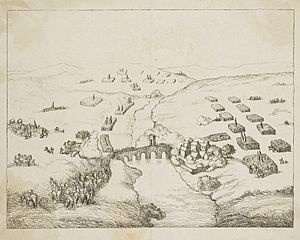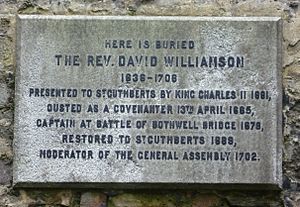Battle of Bothwell Bridge facts for kids
Quick facts for kids Battle of Bothwell Bridge |
|||||||
|---|---|---|---|---|---|---|---|
| Part of Scottish Covenanter Wars | |||||||
 Monument to the Battle of Bothwell Bridge |
|||||||
|
|||||||
| Belligerents | |||||||
| Commanders and leaders | |||||||
| Strength | |||||||
| c.6,000 | c.5,000 | ||||||
| Casualties and losses | |||||||
| c.600 | few | ||||||
| Designated | 21 March 2011 | ||||||
| Reference no. | BTL5 | ||||||
The Battle of Bothwell Bridge, also called Bothwell Brig, happened on June 22, 1679. It was a fight between the Scottish government's army and a group of religious rebels called Covenanters. This battle marked the end of a short rebellion by the Covenanters.
The fight took place at a bridge over the River Clyde. This bridge is near Bothwell in South Lanarkshire, Scotland. Today, the area where the battle happened is a protected historic battlefield.
Contents
Why the Battle Happened
Covenanters and the King
After King Charles II returned to the throne, many Presbyterians in Scotland faced unfair treatment. They were punished for their religious beliefs. A small uprising by them had been stopped in 1666.
Some Presbyterian ministers were allowed to keep their churches. This was if they accepted the King's church leaders, called bishops. But many Covenanters refused to accept bishops. They wanted to worship freely without government control.
Outdoor Meetings and Clashes
These strict Covenanters held illegal outdoor church meetings. These were known as "conventicles." Government soldiers, called dragoons, often broke up these meetings. One famous leader of these soldiers was John Graham of Claverhouse.
On June 1, 1679, Claverhouse met Covenanters near Loudoun Hill. But his soldiers were defeated by the armed Covenanters. This happened at the Battle of Drumclog. Claverhouse had to escape to Glasgow.
Building Armies
After their win at Drumclog, the Covenanters gathered more fighters. The government also prepared for a bigger fight. King Charles II sent his son, James, Duke of Monmouth, to lead the army. More soldiers were also called up to join the fight.
The Battle of Bothwell Bridge
Covenanter Camp and Problems
The Covenanters set up their camp on the south side of the River Clyde. This was north of Hamilton. They had about 6,000 men. However, they were not well-trained. They also had many disagreements about religion.
They did not have many good leaders. Robert Hamilton of Preston was their main leader. But his strict views caused more arguments among them. Other important Covenanters there included Donald Cargill and William Cleland. Cleland was the winner of the Drumclog battle. Also present were David Hackston and John Balfour of Kinloch. These two were involved in the killing of Archbishop Sharp.
Government Army
The government army had about 5,000 regular soldiers and local fighters. Monmouth led this army. He was helped by Claverhouse and the Earl of Linlithgow. The King's soldiers gathered on the north side of the Clyde. This area is now sometimes called the Covenanters Field.
Fighting at the Bridge
The main part of the battle was at the narrow bridge over the Clyde. Monmouth needed to cross this bridge to reach the Covenanters. Hackston led the Covenanters defending the bridge. They did well at first in the small fights there.
But Hackston's men did not have enough cannons or bullets. After about an hour, they had to pull back. Once Monmouth's soldiers crossed the bridge, the Covenanters were quickly defeated.
After the Bridge
Many Covenanters ran into the nearby parks of Hamilton Palace. This was the home of Duchess Anne. She was friendly to the Presbyterian cause. The last parts of the battle happened in this area.
The number of Covenanters killed is not exactly known. Estimates range from 7 to 700. About 1,200 Covenanters were captured by the government army.
What Happened Next
Prisoners and Punishment
The captured Covenanters were taken to Edinburgh. They were held on land next to Greyfriars Kirkyard. This area is now known as the Covenanters' Prison. Many stayed there for several months.
In November, most of them were sent away to colonies overseas. But one ship sank, and 48 of the 257 prisoners managed to escape.
The Killing Time
Everyone who fought for the Covenanters was called an enemy of the King. The harsh treatment during this time is known as "the Killing Time" in Covenanter stories.
A small group of very determined Covenanters kept fighting. They became known as the Cameronians. This was after their leader, Richard Cameron. Cameron was killed in a fight the next year. But his followers were eventually forgiven. This happened when William and Mary became King and Queen in 1689.
Remembering the Battle
In Books and Poems
The Battle of Bothwell Bridge is a main event in Sir Walter Scott's 1816 novel, Old Mortality. Scott made up some parts of the story. He included real people who were not actually there. But his description of how the battle unfolded is thought to be correct.
A poem by Letitia Elizabeth Landon called Claverhouse at the Battle of Bothwell Brig was inspired by Scott's novel.
Monuments
In 1903, a monument was put up at the battle site. This was 224 years after the battle. It stands next to Bothwell Bridge. The bridge itself was mostly rebuilt in the 1800s.
Images for kids
See also
 In Spanish: Batalla del puente de Bothwell para niños
In Spanish: Batalla del puente de Bothwell para niños






